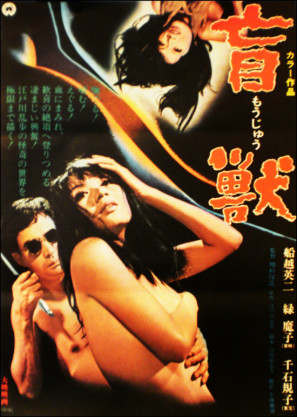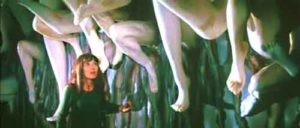 A wildly fetishistic, claustrophobic Japanese production made in 1968, THE BLIND BEAST (a.k.a. MOJU) is profoundly bizarre. It’s hard to know how to respond to its excesses; some moments are genuinely unsettling, others merely provoke (unintended?) laughter. At any rate, this is one of the few films I can unhesitatingly recommend with the old cliche: You’ve never seen anything like it.
A wildly fetishistic, claustrophobic Japanese production made in 1968, THE BLIND BEAST (a.k.a. MOJU) is profoundly bizarre. It’s hard to know how to respond to its excesses; some moments are genuinely unsettling, others merely provoke (unintended?) laughter. At any rate, this is one of the few films I can unhesitatingly recommend with the old cliche: You’ve never seen anything like it.
You’ve never seen anything like it.
Based upon a novel by Edogawa Rampo, Japan’s leading mystery writer, this outrageous film was directed by Yasuzo Masumara, the father of the Japanese “New Wave” of the sixties. While it might not exactly be on the tip of everyone’s tongue today, THE BLIND BEAST caused quite a stir during its initial release, eclipsing in notoriety all of Masumara’s other (oft-outrageous) films. Its influence on Japanese cinema has been wide-ranging, most notably in the films of Nagisa Oshima. The latter’s ground-breaking IN THE REALM OF THE SENSES (a.k.a. AI NO CORRIDA, 1976), with its story of obsessive, all-consuming physical passion, owes much to Masumara’s film. See also David Cronenberg’s SCANNERS, whose giant sculptures look suspiciously familiar.
THE BLIND BEAST caused quite a stir during its initial release, eclipsing in notoriety all of Masumara’s other (oft-outrageous) films.
Playing on themes of male dominance and objectification of the female body, the story concerns a young model, Aki, who is kidnapped by Michio, a blind, demented sculptor determined to create the perfect statue. He takes her to a secluded farmhouse where he lives with his mother. The house contains a bizarre room, the sculptor’s masterpiece. In one of the most unusual settings in film history, each wall contains large reproductions of the female anatomy: One wall shows nothing but eyes, another noses, etc. In the center of the room two giant nude bodies recline, one male, one female.
 At first Aki is understandably distraught, but she comes to respect and even love her captor, eventually going blind herself due to lack of sunlight (the room’s only illumination is a ghostly ceiling light). The film’s remaining moments are a series of increasingly violent sado-masochistic sex scenes as the two attempt to come together atop the giant nude sculptures. The film climaxes with Michio chopping off Aki’s arms and legs (nearly twenty five years before Jennifer Lynch’s BOXING HELENA), and then committing suicide.
At first Aki is understandably distraught, but she comes to respect and even love her captor, eventually going blind herself due to lack of sunlight (the room’s only illumination is a ghostly ceiling light). The film’s remaining moments are a series of increasingly violent sado-masochistic sex scenes as the two attempt to come together atop the giant nude sculptures. The film climaxes with Michio chopping off Aki’s arms and legs (nearly twenty five years before Jennifer Lynch’s BOXING HELENA), and then committing suicide.
The film climaxes with Michio chopping off Aki’s arms and legs (nearly twenty five years before Jennifer Lynch’s BOXING HELENA)…
A simple plot summary cannot do justice to the psychotic, near-otherworldly aura this film achieves. Nothing like this has been done before, or since. Making the most of his claustrophobic setting, Yasuzo Masumara uses mostly static shots, with the gigantic body parts often crowding the foreground. He also focuses relentlessly on hyperbole and grotesquerie, employing graphic (for 1968) sex and violence (in keeping with the lurid storyline). Some will argue that he makes his point a little too explicitly, often provoking laughter. Still, the tone is everything: Masumara sucks us into a world where body parts exist as fetish objects and true human contact is impossible. The film is a throwback to a time when movies really took chances. It’s also a prime example of Japanese cinema at its most demented. You have been warned…
Vital Statistics
BLIND BEAST (a.k.a. MOJU)
Daiei Productions
Director: Yasuzo Masumara
Producer: Masaichi Nagata
Screenplay: Yoshio Shirasoka
(Based on a novel by Edogawa Rampo)
Cinematographer: Setsuo Kobayashi
Cast: Eiji Funakoshi, Mako Midori, Noriko Sengoku
